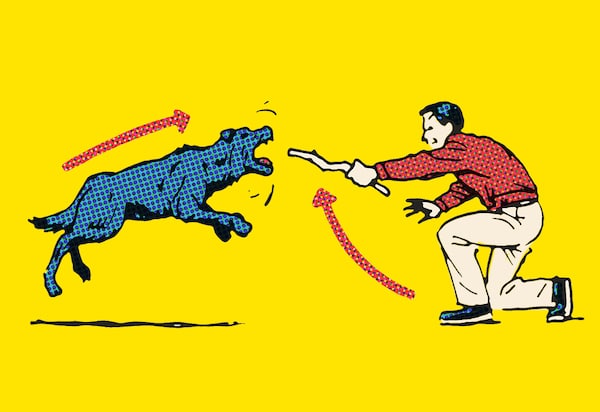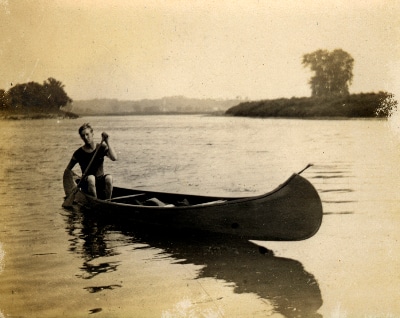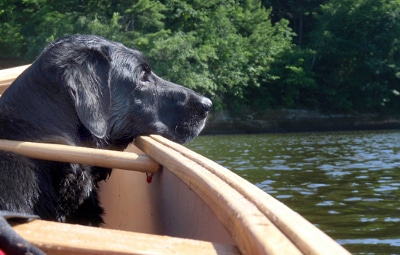
Editor’s note: This is a guest post from Darren Bush.
Most people who know me know I have a dog-friendly house. There’s always one to three dogs at the house, depending on who I’m dog-sitting. Once I was getting a boat ready for a trip on the front lawn, with Amazing Grace (Gracie, my black lab) sniffing at all the gear. A lady with a lab puppy walked by and said, “You’re not taking your dog in that canoe, are you?” I answered that I was indeed taking Gracie with me.
She told me she’d love to take her dog and she wanted to know how to deal with dogs in canoes. That’s like asking, “How do you raise prizewinning tomatoes?” There are as many ways to deal with dogs in boats as there are dogs. Dogs’ temperaments are different, the canoes they’re in are different, and the paddling skills of their humans are at different levels.
That said, there are a few things I’ve learned from having Gracie (now 10) and Winnie (our German Shorthair Pointer, R.I.P.) as paddling partners for over fifteen years.
The way to have a successful outing with your dog requires that your dog is comfortable, both physically and psychologically. There are a few ways I’ve found that work very well.
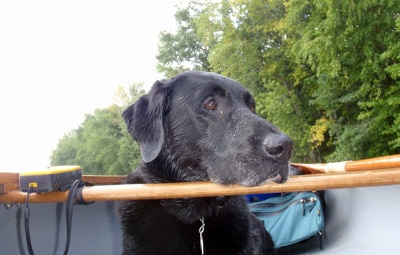
First, dogs appreciate sure footing. They don’t like sliding around the bottom of a wet canoe. Many modern canoe materials are fairly slick when wet, and what isn’t wet at the beginning of the day will be once a dog jumps in and out a few times. Royalex or polyethylene canoes are especially slick.
I’ve found that bathtub tape or textured dock tape will adhere nicely to a canoe if you give the boat a good cleaning. The chemical agents that manufacturers use to release boats from molds are not adhesive-friendly, so be sure to scrub them good with Dawn and a greenie pad. You don’t need to cover the whole bottom of the boat, just the areas where your dogs like to go. (Note that this abrasive tape will wear holes in your packs if you put them on the tape and let them slide around.)
Another idea that I hear works but that I haven’t tried is one of those bathtub mats with suction cups all over the bottom. I’ve also heard of people using indoor-outdoor carpeting or, in some flat-bottomed boats, a thin piece of plywood or OSB. At any rate, it’s a good idea to give them something into which they can dig their claws.
Aluminum boats can become very hot in the sun. A dog with sensitive pads might not appreciate the reflective capacity of an aluminum canoe. Keep that in mind as well.
Second, dogs don’t like laying in bilge water. Even though your dog might be jumping in and out of the boat constantly (more on that later), they don’t like laying in a puddle of water. A little is fine, but some boats, especially those with shallow V hulls, collect significant bilge water. Dogs won’t lay down in an inch of slimy river goo.
A small platform can be called for if you have a smaller dog—they like to see over the gunwales, and it will keep them out of the bilge water and much happier. A 1/4″ piece of plywood is plenty strong. You will want to make sure that it fits your boat, doesn’t move around, and does not pose an entrapment hazard to human or canine.
Third, some dogs need lifejackets too. I don’t care if your dog, like mine, is a natural born swimmer. Labs can be headstrong, and I’ve seen strong dogs exhaust themselves trying to swim against current, and there are hazards in rivers and lakes that are as dangerous to dogs as they are to humans—perhaps more so, because many dogs lack the judgment necessary to deal with snags and strainers (trees that have fallen into the river, straining the current). A good dog flotation device will help your dog keep his or her nose out of the water easily, they will ride higher in the water and are therefore safer, and there is a nice handle on the back of most dog floaters to facilitate grabbing them when you need to get them out of the water quickly.
Fourth, never leash your dog to the boat. You wouldn’t tie a rope around your own neck and the other to your yoke, would you? If you must keep a leash on your dog, put the leash under your foot. Under no circumstances should you tie anything to you or to your dog. If your dog strains at the leash constantly, the answer is more training, not a bigger leash.
Don’t assume because a dog isn’t a natural “water dog” (Lab, Pointer, etc.) that he or she won’t enjoy the water. Our friends have a Staffordshire Terrier that loves the water but has the density of plutonium. A little flotation makes Petey a happy pup. Their pug Violet, however, is pretty much a shore dog.
That takes care of the physical set up of your canoe (and your dog). The psychological part is just as important. Training your dog to like a canoe is not always an easy task. Mine was trained as a puppy, and although the dock was solid and the boat anything but, Gracie would rather do anything than be left behind.
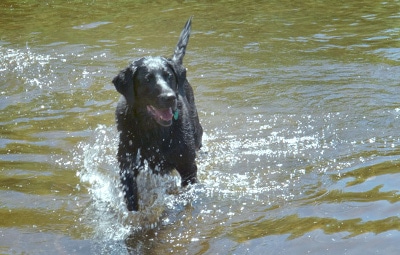
Basic training principles apply. Small, incremental steps leading to the desired behavior need to be reinforced. Get some of the smelliest dog treats and cut them up into small pieces. With the canoe on dry land, toss a few into the canoe. Encourage jumping in and out, playing around, and generally becoming familiar with the canoe. You might even throw the dog bed in the canoe when you’re doing some yard work and let your dog become more accustomed to the environment.
Once your dog is happy about dry land, tie your boat up to the dock and do the same thing; treats go in, dog goes in. Coax out, treat, praise. Lather, rinse, repeat. Then try sitting in the canoe (still at the dock) and lure your puppy in. Rock the canoe gently. Reward, praise. Take a little paddle. Reward, praise.
Dogs are curious, and the rule (for Labs anyway) is that if they are in, they want out, and if they are out, they want in. If they go to sleep, chances are a duck will fly over and wake them. If they spend enough time in the canoe, they will eventually figure it out, and it won’t be a big deal at all. They will eventually habituate and calm down.
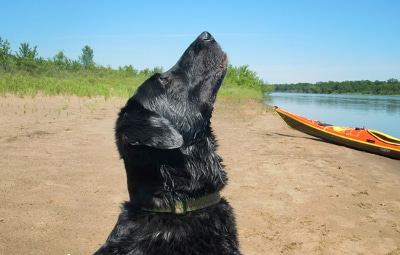
Take all this advice with a grain of sand. It worked for me. Whatever you do, do it with a sense of humor and you will be rewarded with a traveling companion who will add a new dimension to your paddling.
Be sure to listen to our podcast about how a canine companion can be a midlife crisis fixer:
_______________________________________________________________________
 Darren Bush is the owner and Chief Paddling Evangelist of Rutabaga, but he’s also an amateur blacksmith, longbow shooter, and primitive skill aficionado. He believes primitive skills are highly undervalued in modern society.
Darren Bush is the owner and Chief Paddling Evangelist of Rutabaga, but he’s also an amateur blacksmith, longbow shooter, and primitive skill aficionado. He believes primitive skills are highly undervalued in modern society.


